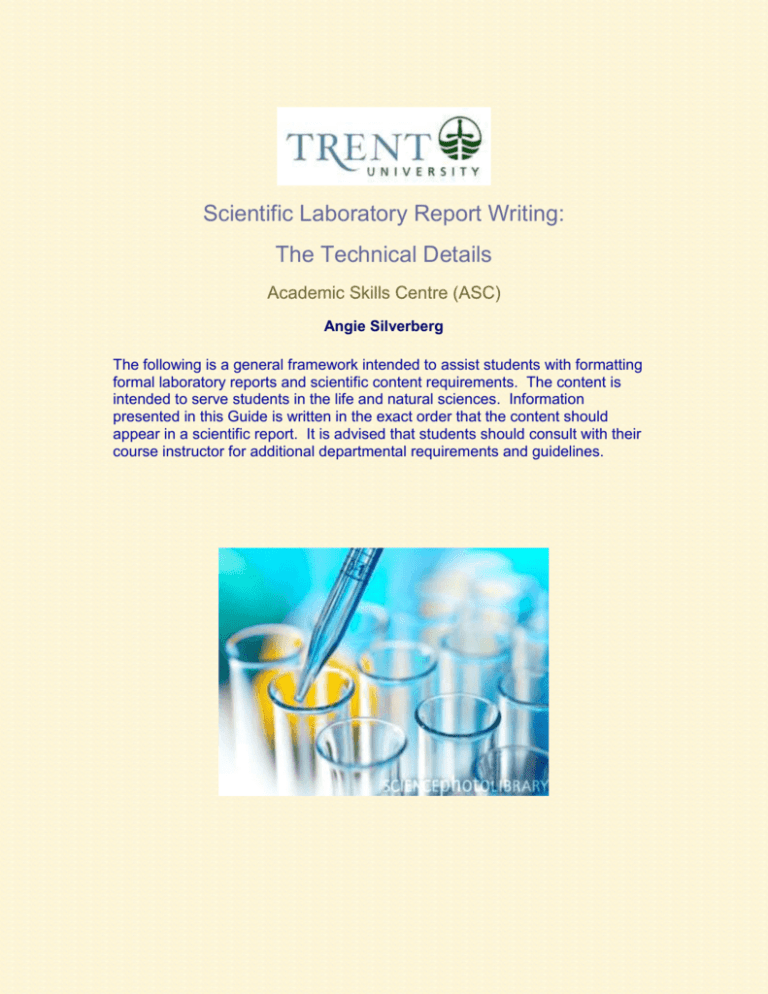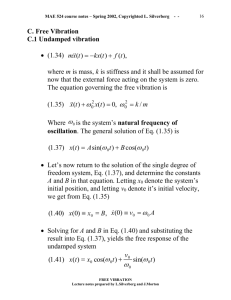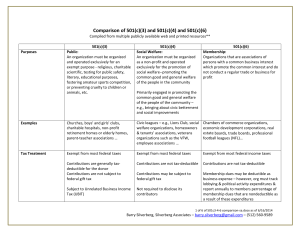
Scientific Laboratory Report Writing:
The Technical Details
Academic Skills Centre (ASC)
Angie Silverberg
The following is a general framework intended to assist students with formatting
formal laboratory reports and scientific content requirements. The content is
intended to serve students in the life and natural sciences. Information
presented in this Guide is written in the exact order that the content should
appear in a scientific report. It is advised that students should consult with their
course instructor for additional departmental requirements and guidelines.
Laboratory Report Title Page
Shown below are the basic components of an acceptable title page. It is
advisable to check with the individual course instructor regarding required
specifics. Please note a title page is not given a page number.
Tollen’s Test for the Presence of Carbohydrate Molecules in
Seven Unknown Solutions
(Concise title)
Presented to: Angie Silverberg, Director of Academic Skills Centre
(Person(s) to whom the report is submitted)
Academic Skills Centre
Trent University
(Affiliation of author(s))
September 17, 2010
(Date of Submission)
I verify this report contains my own original ideas, concepts and
experimental design. Any material that was not derived from my own
conception has been properly cited within the body of the text and
documented in the reference section. (Academic integrity statement)
Rachel Silverstone
Rachel Silverstone
(printed student name)
(student signature) (date)
A. Silverberg, March 29, 2011
September 17, 2010
2
Abstract
Inclusion of an abstract is dependent upon the type of document being written as
well as individual course requirements. Formal laboratory report submissions
and theses must include an abstract. An abstract is situated immediately after
the title page, but prior to the Table of Contents. An abstract is assigned a page
number using roman numerals, specially identified as page (i). To accurately
reflect the content of the thesis or formal laboratory report, the abstract must be
written after the entire document is completed. While an abstract is attached to
the document being submitted, it needs to be treated as an entirely separate
document. Abstracts are very short. They are typically ½ to 1 page long, and
are results-and conclusion-orientated. According to Macartney (1998), a
scientific style abstract consists of:
A specific and tactful title (normally the same title as the report)
List of authors
A clear and concise purpose statement
Well-defined procedure
Summary of important results and discussion
Principle recommendations
According to Jeter and Donnell (2004), the abstract should very briefly provide
answers to the following questions:
What was the problem being addressed?
How was the experiment conducted?
How was the experimental data evaluated?
What are the result(s) obtained from the experiment?
Examples of well written, published abstracts are included below. Note the main
features always include a purpose statement, procedure, summary of results and
main conclusions.
Ahmed, S.; Mathews, A.S.; Byeon N. et al. Anal. Chem., 2010, 82 (18), 75337541.
Hovanec, B.M. J. Anal. At. Spectrum., 2004, 19 (9), 1141-1144.
Murner, H.; Jackson, B.A.; Barton, J.K. Inorg. Chem., 1998, 37 (12), 3007-3012.
(These articles are available electronically through the Trent University Bata
Library)
A. Silverberg, March 29, 2011
3
Table of Contents, List of Figures, List of Tables
The Table of Contents, List of Figures and List of Tables appear sequentially
after the abstract. The abstract and associated tables are numbered numerically
with roman numerals. The abstract is numbered as page (i), Table of Contents
(ii) and so on. The Table of Contents is intended to display all headings and
sub-sections from the introduction section to the conclusions section, including all
individual appendix titles with page numbers aligned on the right hand side. Lists
of tables and figures include table or figure numbers, description with page
numbers aligned on the right hand side of the document. All figures and tables
should be listed in their respective tables in the order they appear in the report.
See below for examples of Table of Contents and List of Figures:
Table of Contents
PAGE
ABSTRACT ………………………………………………………………………..
LIST OF FIGURES ……………………………………………………………….
LIST OF TABLES ………………………………………………………………...
i
ii
iii
1. INTRODUCTION
1.1 Principles of nebulizer function ……………………………………
1.2 Spray Chamber Operation …………………………………………
1.3 Torch Fundamentals ……………………………………………….
1.4 Mass Spectrometer Design & Function ………………………….
1.5 Successful hyphenated techniques ………………………………
1.6 Environmental Applications …………………………..…………..
1.4 Project Objective ………………………………………………..…
2
5
10
16
10
25
34
2. EXPERIMENTAL
2.1 Solution Preparation ………………………………………………….
2.2 Instrument Set-up and Operation Parameters …………………….
35
40
List of Figures
PAGE
1.0
2.0
3.0
Typical Meinhard Nebulizer ……………………………………………… 3
Scott Double Pass Spray Chamber …………………………………….. 7
Quartz Torch Showing Regions of NAZ and IRZ ……….…………….. 17
A. Silverberg, March 29, 2011
4
Introduction
Include a comprehensive review of the fundamental theory related to the
research or experiment objective. Review of relevant literature conducted
prior to writing the introduction section is vital.
All theoretical concepts are to be well cited and referenced throughout the
document.
To assist with discussion and understanding of fundamental concepts,
good use of structures, diagrams and/or mathematical or reaction
equations are highly recommended. Every structure, diagram or equation
is numbered sequentially and should be cited at least once within the body
of the text. Typically the citation occurs first, followed by the embedded
item. Numbering of structures, diagrams or equations typically falls into
respective groups. For example, figures may include structures and
diagrams. Equations and tables belong to their own respective categories
and are numbered independently.
A discussion of the work previously completed in the area is normally
included toward the end of the introduction and should review current
limitations of work completed to date.
It is important to include a clear and specific project objective statement
based on sound theoretical principles.
Experimental
A thorough experimental procedure will include the following elements:
Description of all the chemicals/reagents/purchased materials used for
experimentation including the Manufacturer name, Manufacturer location
and degree of purity (thesis only).
Specifics of chemical solution preparation including quantities and
resultant concentrations.
Include the name of biological species and sampling procedure if
appropriate.
Instrument(s) name(s), including make and model number (thesis only).
All instrument operating parameters and calibration procedures used to
conduct the experiment.
The type and quantity of materials used throughout the experiment. For
example: 50 mL polypropylene beaker or 20 cm of 0.50 i.d. Tygon tubing.
Labeled schematic diagrams may include equipment breakdown, reaction
mechanisms, fluid directional flow etc.
Safety considerations (undergraduate reports only)
Remember, the procedure should be detailed to ensure that someone else
can repeat the experiment and obtain a similar result.
A. Silverberg, March 29, 2011
5
Results and Discussion
A results and discussion section should include the following components:
Data presented in a meaningful form and order. The form of the data may
include plots, tables and/or figures. Raw data and long sets of data are to
be presented into appendices only.
Ensure units are used consistently!
Sub-headings are helpful to maintain organization and logical presentation
of information. It is important to guide the reader in a logical fashion.
Use statistical analysis to compare experimental results such as. F-tests,
T-tests etc., to prove the validity of results. Refer to the Guide on
“Statistics for Students in the Sciences” for assistance with the appropriate
tests.
Interpretation of results may include a discussion of major experimental
trends, assumptions, errors, inconsistencies, comparison to the literature
with references.
Conclusions and Recommendations
The final section of the report is designed to be concise and convincing:
Briefly summarize major conclusions or trends developed from the
discussion section. These conclusions are to be situated in order of
importance.
It is essential to introduce NO new information in this section.
Mention other parameters or improvements worth investigating in future
work.
Conclude with strong and convincing recommendations.
References
All ideas NOT original to the author(s) of a laboratory report MUST be properly
documented. Lists of materials that require documentation are endless.
Examples of material may include lectures, conferences, textbooks, journal
articles, lectures, ideas from coworkers, online resources etc. Please refer to the
Academic Skills Centre Documentation Guide for helpful documentation tips.
http://www.trentu.ca/academicskills/documentation/
Any idea that is NOT original to the report author is considered plagiarism.
Plagiarism is considered a serious academic offense. Please refer to the Office
of the Associate Dean of Arts & Science for details regarding academic integrity.
http://www.trentu.ca/academicintegrity
A. Silverberg, March 29, 2011
6
According to Pfeiffer and Boogerd (2003), referencing within a body of the text
would include the following examples for indirect quotes:
Example 1: According to Atkins et al., (1995), the kinetic energy of a body is
defined as the energy it possesses as a result of its motion.
Example 2: Atkins et al., (1995) concluded that the kinetic energy of a body…
Example 3: Atkins and coworkers (1995) stated that the kinetic energy…
Example 4: The kinetic energy of a body is the energy it…. (Atkins et al., 1995)
Example 5: The kinetic energy of a body is the energy it possesses as a result of
motion1. (The number “1” refers to an author(s) listing in the reference section of
the report. Authors in this case are numbered in the order they are cited in the
body of the text.)
Appendices
Appendices contain a wealth of very detailed information that is not essential to
the understanding of the formal report. Items in an appendix may include, but
are not limited to primary data, intermediate results, sample calculations or
detailed mechanism diagrams. The appendix section appears immediately after
the reference section. Appendices are numbered and listed in the order that they
appear in the text. In general, Appendix A or Appendix 1 should be the first
appendix referred to in the body of the report or thesis.
Graphs
Graphs are one of the most important exhibits in a thesis or laboratory report. A
graph is designed to present data or information in a comprehensive manner and
reveal important trends or relationships between dependent or independent
variables. An effective graph presents data in a logical and visually condensed
format. There are rules for constructing an effective graph:
Ensure the plot is clear, concise, legible and uncluttered.
Include one legend only. Place the legend underneath the graph.
Remove all shading or horizontal lines from the graph default initially
created by Excel.
Use Excel XY or scatter graphs. Line plots are strictly reserved for
business presentations.
Clearly label the X and Y axes indicating appropriate units in brackets.
Select an appropriate X and Y axes scale to ensure the plotted line spans
across the entire plotted region.
A. Silverberg, March 29, 2011
7
An equation for the line of best fit is written on the graph just above the
plot.
A figure number and detailed name is included below the graph.
Place each graph in the order it is discussed in the body text.
Refer to all graphs in the body of the text at least once.
Properly reference graphs not original to the report writer.
Use distinctive line types rather than a variety of line colors for theses, as
publications are not color printed.
Shown below is an example of an appropriate plot:
3000
Counts/s
2500
2000
1500
1000
500
0
0
10
20
30
40
50
60
Concentration/ppb
Figure 1: Calibration Plot for Arsenic Speciation Analysis of Mushroom Samples
from Yellowknife using flow injection techniques coupled with ICP-MS
Note: plots which represent a line of best fit are drawn as a straight line,
obtained from the regression feature using Excel.
If a graph is not an original piece of work, the names of the original author(s)
would appear in brackets following the graph title as shown:
A. Silverberg, March 29, 2011
8
3000
Counts/s
2500
2000
1500
1000
500
0
0
10
20
30
40
50
60
Concentration/ppb
Figure 1: Calibration Plot for Arsenic Speciation Analysis of Mushroom Samples
from Yellowknife using flow injection techniques coupled with ICP-MS
(White, J.A. and Blacksmith L.M., 2010)
Be advised each plot contains the following key items:
Units
Clear and visible format
Appropriate X and Y scale
Labeled X and Y axis
A dependant variable on the y-axis
Practice: Based on the information provided, identify the features that make this
an inappropriate graph.
counts vs conc
5000
4500
4000
3500
3000
2500
2000
1500
1000
500
0
counts vs
conc
0
40
A. Silverberg, March 29, 2011
80
120
160
9
Answer:
Range of the x-axis scale is too large. A scale of 0 to 60 would be ideal.
Range of the y-axis is too large. A scale of 0 to 3000 would be better.
Both major and minor ticks on an x and y-axes are useful for the reader.
A legend is not required for a single line.
Gridlines are not acceptable.
Background of the plot is grey. A white background is preferred.
The plot title is too vague.
There are no axes labels with units included.
The graph is not given any sequential number such as Figure 1.
Graph title is incorrectly placed above the plot. The title should be appear
below the graph.
Illustrations
Illustrations may include, but are not limited to tables, diagrams/schematics and
pictures. The following are desired attributes of illustrations:
Label and number each illustration chronologically.
Place descriptive titles underneath captions.
Properly reference illustrations not original to the report writer.
Provide units, appropriate significant figures and definition of variables.
Clearly label schematics and indicate direction of flow if applicable.
Guidelines for Table Format:
Place descriptive titles above a table.
Number tables in chronological order as they appear in the text.
Include units in the category header only.
Use appropriate degree of precision.
Centre numbers with respect to the decimal place.
An example of an appropriate table would include:
Table 1: Concentration Dependence on Soil Slurry Particle Size
Experimental Concentration of
Slurry Particle Size
Lead (ppm)
(m)
20
20
470
10
830
5
1060
<2
Certified value for Pb is 1060 ppm
A. Silverberg, March 29, 2011
10
Other Important Formatting items:
Number all pages on the bottom right hand corner.
Avoid jargon or slang in technical/scientific writing.
Double space the document. The only exceptions are the list of
references, table of contents, list of figures and list of tables. These items
are single spaced.
Choose font size 12 and font type Times New Roman or Arial.
Do not draw boxes around figure captions.
Avoid colors unless they truly contribute to a figure. Thesis students, keep
in mind publications cannot duplicate color; they are printed in black font.
Proofread all materials for spelling and grammar. A secondary reader can
provide additional comments concerning clarity and writing style and can
correct for scientific content.
List of References
Pfeiffer, W.S.; Boogerd, J. 2004. Technical Writing: A Practical Approach. Third
Canadian Edition. Toronto: Pearson Prentice Hall.
Macartney, D. 1998. Principles of Scientific Communication. Queen’s
University.
Misseri, A., 2007. Guide To Writing Technical Formal Reports, Queen’s
University, Kingston, Ontario. Available online at:
http://www.chemeng.queensu.ca/courses/reports/guide.php
Science Photo Library [online]. Cited September 23, 2010. Available online:
http://www.sciencephoto.com/images/channel/technoscience.html
Sheldon, S.; Donnell, J. 2004. Writing Style and Standards in Undergraduate
Reports. Virgina, USA: College Publishing.
The Academic Skills Centre
www.trentu.ca/academicskills
acdskills@trentu.ca
705-748-1720
A. Silverberg, March 29, 2011
11












